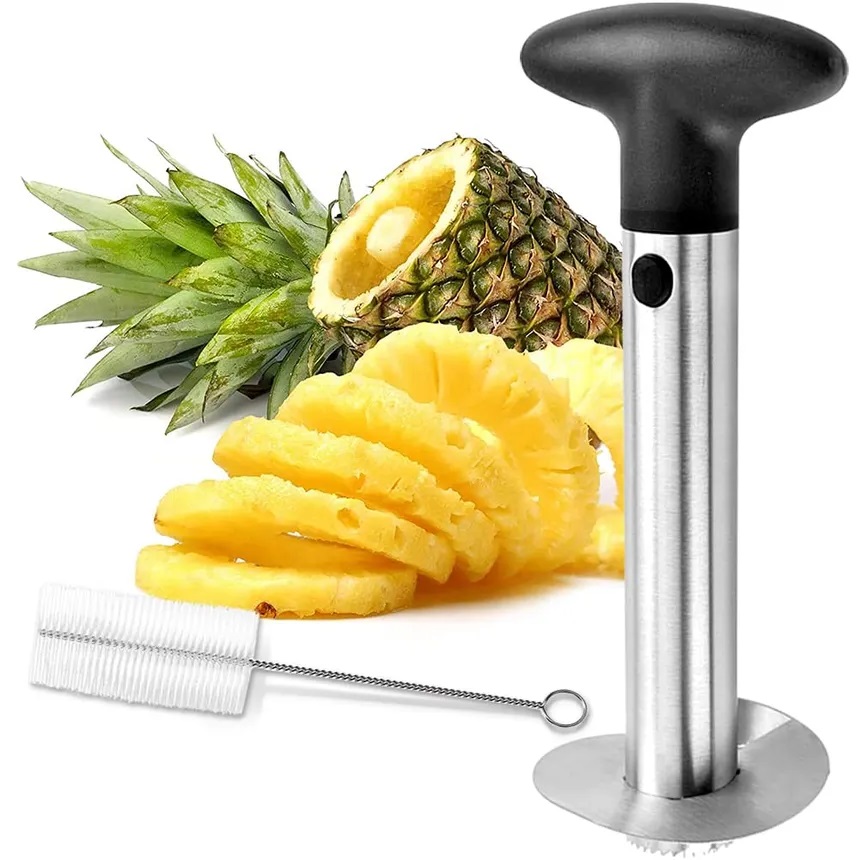If you’ve ever been intimidated by the idea of cutting up a fresh pineapple, you’re definitely not alone. That tough, spiky skin, the hard inner core, and the mess that follows can make anyone think twice before buying a whole fruit. But that’s exactly why tools like the pineapple peeler and corer were invented, to make the entire process easier, quicker, and a whole lot safer. However, to fully enjoy the benefits of this handy tool, it’s essential to know the right way to use it, especially when safety is concerned.
A pineapple peeler and corer isn’t just a convenience; it’s a smart way to streamline kitchen prep. And much like any sharp kitchen gadget, using it carelessly can lead to injuries. That’s why understanding proper technique and handling becomes crucial, especially in a home environment where kids might be nearby or distractions are frequent.
Interestingly, people who love multitasking or are always optimizing their time, like users of a pineapple peeler and corer, commonly wear, tend to gravitate toward tools that simplify repetitive tasks. But whether you’re a busy mom prepping breakfast smoothies or a food lover experimenting with tropical recipes, safe use of this kitchen tool is the secret to enjoying all its advantages without the risks.
Understanding Your Tool Before You Start
Before diving into pineapple slicing mode, it’s important to get familiar with your peeler and corer. Most versions have a circular, serrated blade that you press and twist into the pineapple to both core and slice it in one motion. There are manual models and some with ergonomic handles for better grip.
Don’t rush this step. Read the small instruction leaflet that often comes with the tool; it might look basic, but it can prevent accidents by explaining the correct placement and angle. Washing the tool before first use is also a must to remove any manufacturing residue.
Handling a tool you don’t fully understand is risky. Just like you wouldn’t wear a smartwatch women depend on without learning its features, you shouldn’t use a kitchen device without mastering its mechanics.
Choosing the Right Pineapple
Safe usage starts before you even touch the tool, it begins with the pineapple you choose. Pick one that’s ripe but still firm. Overripe pineapples can be slippery and mushy, making them difficult to grip and increasing the chances of the tool slipping mid-use.
Firmness ensures stability during coring. Also, wash the outside of the pineapple before slicing to remove dirt or pesticides that could transfer from the peel to the fruit during the cutting process.
The Cutting Surface Matters
Always work on a clean, dry, and flat cutting surface. Wooden or non-slip cutting boards are ideal. Never use the tool on an unstable surface like a wobbly counter or wet plate. It might sound minor, but these little setup steps are where most safety issues start.
A sliding board or dripping juice can make your hand slip, and when a sharp blade is involved, that’s not something you want. Just as someone checking their smart watch, women love during a workout would pause to tighten the strap, you too should pause to ensure everything is stable before starting.
Step-by-Step Safe Usage Technique
Once your work area is ready and your pineapple is clean and firm, it’s time to cut off the crown (the leafy top). Use a sharp chef’s knife to slice about an inch below the crown, exposing the top of the fruit.
Now place the pineapple upright. Center your peeler’s blade on the core. Start twisting gently but firmly, applying steady pressure as you rotate the handle down through the fruit. You’ll feel some resistance, don’t force it. A steady twist with the correct amount of pressure is all you need.
Once you reach the bottom (but before cutting through the skin), stop twisting. If your model has a release button or handle, use it to pull the tool and the core out of the fruit. What you’re left with is a perfectly cored, sliced pineapple.
Don’t try to rush or muscle your way through the fruit. Speed leads to slips, and slips lead to cuts.
Finger and Hand Placement
Be mindful of where your hands are at all times. Always grip the handle, never the blade area. Keep your non-dominant hand flat on the base of the pineapple (on the cutting board), away from the tool’s path.
If your peeler comes with a safety grip or finger guard, use it. These aren’t just accessories, they’re built-in protective features. Ignoring them is like disabling your smart watch women rely on for heart rate alerts, technically possible, but risky and unnecessary.
Post-Use Safety and Cleanup
Once you’re done, resist the temptation to lick the blade clean (yes, people do that!). Immediately wash the tool under warm water and use a small brush to clean out the sticky fruit bits. Many peelers are dishwasher-safe; check your product label.
Dry it thoroughly before storing to avoid rust or mold, especially in the blade or handle areas. And always store it with the blade covered or pointed down if it’s in a drawer. Even after use, sharp edges can cause accidental cuts when rummaging through kitchen tools.
Kid-Friendly Doesn’t Mean Kid-Safe
Just because a pineapple peeler and corer seems easier to use than a knife doesn’t mean it’s a child-safe gadget. If you allow children to help in the kitchen, make sure an adult handles the tool itself. Kids can watch and learn, but this isn’t a toy.
Some advanced models come with locking mechanisms and blade guards, but even then, children should only use them under strict adult supervision.
Signs You’re Using It Incorrectly
Here are a few red flags to watch for while using your pineapple peeler and corer:
- You’re applying too much pressure and forcing the twist
- The pineapple is rocking or slipping on the board
- You feel the blade catching or sticking
- You’re cutting past the fruit and into the cutting board
- Juice is running uncontrollably and causing slippage
All of these signs point to unsafe handling or improper use. Stop, reset your workspace, and try again more slowly. Practice makes perfect, and in this case, practice also makes it safe.
Understanding the Risks
Even though this tool reduces the use of knives, it’s still a blade-based device. The most common injuries include:
- Hand cuts from improper grip
- Accidental slicing when reaching into drawers
- Blade pinching while twisting
- Eye irritation from juice splashes
Using goggles might be overkill, but washing your hands immediately after use and avoiding face contact is a smart move. If you’ve ever worn a smartwatch women use during a sweaty run and then tried to rub your eye, you know how uncomfortable it can get. The same idea applies here with sticky pineapple juice.
Using the Tool Creatively – But Carefully
You might be tempted to use the peeler on other fruits like melons or to try new cutting angles. But unless the tool is labeled as multi-functional, stick to pineapples only. The blade length, core diameter, and twist mechanism are all designed specifically for pineapples.
Using it on the wrong fruit can bend the blade, break the handle, or lead to slips and accidents. It’s like using your smartwatch that women wear to measure altitude during a swimming session; not all features are universal.
Making It Part of Your Safe Kitchen Routine
Incorporate this tool into a wider routine of mindful cooking. Don’t multitask when using it. Avoid distractions like phones or background noise that might pull your focus away. Many accidents happen not from misuse, but from a lack of attention.
Also, assign it a proper home in your kitchen. Keeping it where you can see it ensures you use it regularly, but also ensures you store it safely.
When to Replace It
Even the best tools wear out. If you notice the blade becoming dull, the handle loosening, or the twist mechanism becoming rough, it’s time to replace the tool. A worn-out gadget is not just ineffective, it’s unsafe.
A new pineapple peeler and corer doesn’t cost much but could save you from injury and frustration.
Final Thoughts
So, what’s the right way to use a pineapple peeler and corer safely? It starts with preparation, understanding the tool, choosing the right pineapple, and setting up a safe workspace. Then it’s about using the correct technique, firm but gentle twisting, proper hand placement, and maintaining control. Finally, it ends with safe cleanup, storage, and mindful routines. This little gadget can bring so much ease to your kitchen life, but only when used with care and respect. It’s proof that sometimes, the smartest solutions are the simplest ones. Whether you’re a tech-savvy multitasker who wears a smartwatch that women adore or just someone looking to enjoy fresh pineapple without the hassle, safety should always be part of your recipe.









